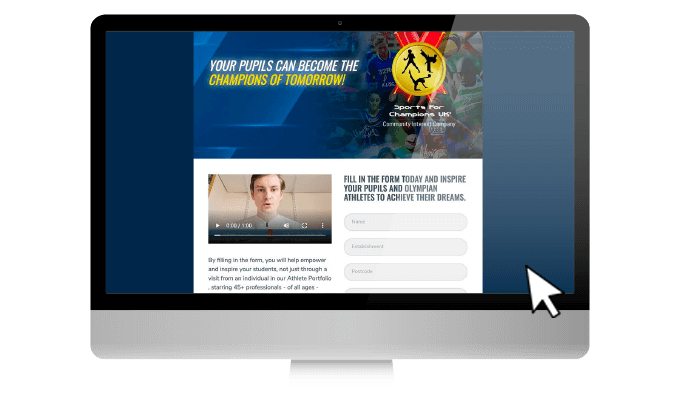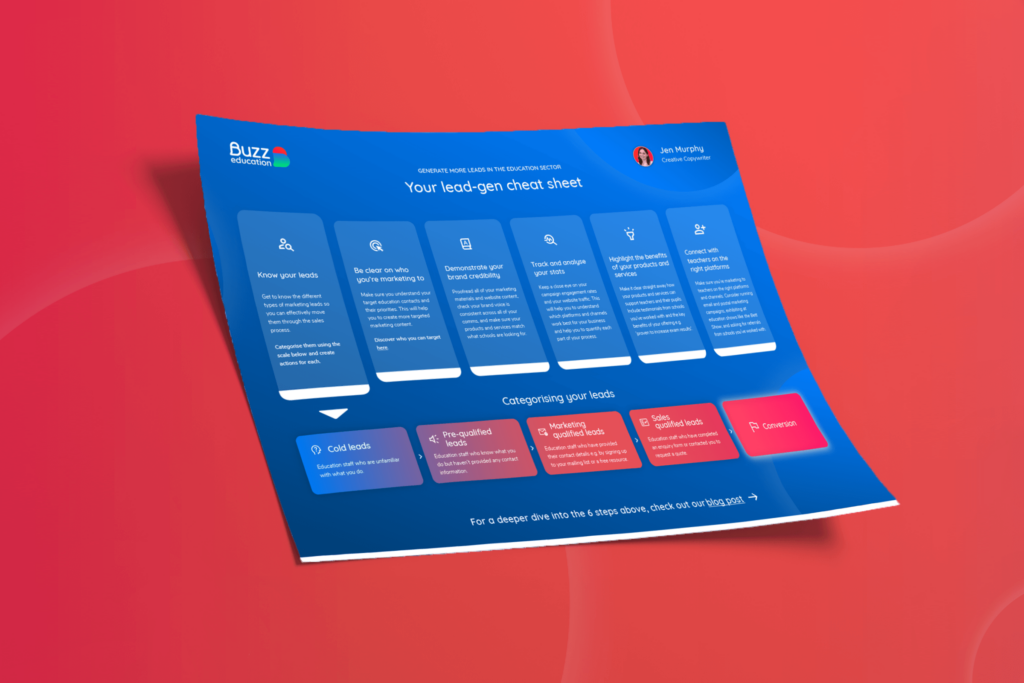


6 tips to generate more leads in the education sector

As the famous proverb goes, ‘if you fail to prepare, you prepare to fail’. And that applies to all marketing activities, but especially marketing to education.
It’s not the easiest territory to navigate and it takes time to get right. But once you understand the craft of marketing to schools and the many (often unexpected) intricacies to marketing to head teachers, business managers, teachers, and the wider education community, it gets easier. Just always remember, preparation is key.
To accelerate your existing lead-generation strategy, I chatted to Michael, our MD (and former senior teacher), to find out his 6 tips for generating more leads in the education sector. They’ll give you a good starting point for your marketing to education and help you plan your next steps.
1. Create a strategy for the different types of leads
It’s important to first consider how you’re categorising your leads. Do you have a strategy in place to accommodate the different types of leads?
For example, if a teacher clicks through to your website, do you have a plan to collect their data?
This could be a website pop-up encouraging them to sign up to your mailing list or a quick form to download a free resource. (If you’ve already got this in place, go you!). Do you have a strategy for using the data collected? Or, if a teacher is further down the line and they’ve already given you their email address, do you have a series of follow-up emails to send them?
Whether you’ve nailed your lead-generation strategy or you’re just laying the foundations, use the categorisation system below to maximise your conversions.
Cold leads
Example: Teachers and decision makers or schools who are unfamiliar with your company. They might be your ideal target but they don’t know enough about you or what you do to get in touch.
- Create a strategy to increase your brand awareness and promote your products and services.
- Run marketing campaigns and advertisements, ask schools you’ve worked with to recommend you and create an SEO strategy to improve your website rankings.
Pre-qualified leads
Example: Website visitors who’ve browsed your pages, social media visitors, education staff who’ve opened your emails.
- Focus your efforts on collecting data from them e.g. through adding website pop-ups or email subscriber forms.
- You’ll be able to use the data to start connecting with them and building your brand awareness.

Marketing qualified leads
Example: Website visitors or social media visitors who’ve provided their data by completing a form or downloading a resource.
- Nurture these leads and get them closer to converting with a series of follow-up emails or a phone call if they’ve provided their telephone number.
Sales qualified leads
Example: Education staff who’ve completed your enquiry form.
- Make sure you respond swiftly (within 24 hours).
- If you provide quotes or sales proposals, invest time into making sure they look great – use strong visuals and a clean layout that’s easy to navigate.
- Make sure the information matches their needs. Teachers are busy, so the easier you make it for them to locate the information they’re looking for, the better their impression of you and the more likely they’ll be to convert.
2. Understand your education audience
Knowing who you’re talking to is key to generating leads in the education sector. And it really helps to know what your ideal customer looks like. The more specific you can be about your target audience, the more targeted you can create your marketing content and mailing lists.
You could start by deciding which education establishment you’re looking to target, then the area you’re looking to reach, and, last but not least, the job role of your target recipient:
- Is it a primary school?
- Is it a primary school in the North-West?
- Is it a head teacher in a primary school in the North-West?
I recommend including key school decision makers in your mailing list like the senior leadership team (SLT), as they play an important part in the school spending process.
The SLT includes head teachers, business managers, deputy heads and more.
But it isn’t just the senior leadership team who influence school spending decisions – teachers and support staff do too.

Take a look at the different job roles in schools so you know who to reach and how to approach them.
Just make sure you only target education staff relevant to what you’re offering. For example, if you’re promoting revision workshops, don’t include school site managers in your mailing list as you’ll likely end up with more unsubscribes.
Finally, familiarise yourself with the different types of schools. Consider any specific requirements e.g. are you looking to target schools with a religious affiliation?
Sending out emails en masse to primary schools, secondary schools, academy schools and independent schools might not work well if you’re offering secondary school workshops. So make sure you only reach out to the relevant schools and education establishments.
3. Build your brand credibility
Quality of your written content
To build your brand credibility, you need to make sure the content of your marketing materials is in tip-top shape. It might sound obvious, but your recipients are in the education sector, and teachers can spot a grammatical error a mile off.
Always make sure your content feels like something they’re reading for pleasure and not another piece of work they’re marking.
There shouldn’t be any wrongly placed apostrophe’s’, no misspelt worrds,, And.! No clunky,, phrases’ – see, it doesn’t look great does it?
You should thoroughly proofread all of your content, including:
- All your website pages
- Email marketing campaigns
- Postal marketing campaigns
- Social media posts
And here are some great ways to do it:
- Get someone else to read through it (preferably a copywriter or editor).
- Read your content out loud.
- Read it backwards.
- Run a spell checker through it – there are lots of tools and plug ins to help you with this.
- Run a grammar check.
Brand voice and customer experience
You need to make sure your brand voice is consistent across all of your marketing content – this is key to building your brand credibility.
The last thing you want to do is confuse teachers with multiple personas e.g. an introductory email with ‘Hey there Sally’ and a follow-up with ‘Dear Mrs Smith’.
Here’s what to do:
- Review your website content, emails, proposals and every marketing touchpoint to make sure it all seamlessly fits together.
Ask yourself these questions:
- Is the language used by your sales team consistent with the language used on your website?
- Do the colours used match your brand persona?
- What’s the vibe of your brand (to put it more colloquially) and is it obvious throughout your website, social media channels and marketing campaigns?
Your products and services
Always make sure your products and services are attuned to what schools want and need, as this will help to boost your credibility as an education supplier. (I recommend subscribing to the Government’s daily education updates so you stay in the loop of what’s happening in schools).
Set up a website page or landing page specifically for education that you can direct teachers to. This can be really helpful if your organisation works across multiple sectors and if you have a wide consumer base.
The easier you can make it for teachers to find the information they’re looking for, the higher your engagement rates will be.

Testimonials and case studies from schools can really help to reinforce your credibility so include them if you’ve got some. According to our 2023 School Survey, 67% of teachers like to hear from other teachers to get inspiration for their classroom materials and activities, so testimonials and case studies are a great way to get education staff on board. If you don’t have any testimonials, don’t worry, just add it to your agenda to start collecting some.
4. Review your website and campaign analytics
Take a deep dive into your analytics and spend time reviewing your engagement rates. Think about these questions:
a) Where is the majority of your website traffic coming from? If it’s your LinkedIn page, do you spend enough time optimising your post content?
b) What are your email campaign engagement rates like? If you want to boost them even further, have you tried running A/B tests (e.g. testing different subject lines or different visuals) to identify what works and what doesn’t?
Ultimately, you need to make sure you can quantify each part of your process and identify a clear purpose for each platform. They should each contribute to your lead-generation strategy.
If they’re not performing, then be honest with yourself, and assess whether it would be better to focus your efforts elsewhere – somewhere where the leads are more plentiful.
5. Appear in the right places
Assess whether you’re talking to prospective schools and education establishments in the right places. Here are some of the channels you might want to consider:
Email marketing
Have you thought about running an email marketing campaign to your target education staff? If this is something you already do, is your mailing list personalised and can you reach teachers’ direct inboxes? These are key things to consider when trying to generate more leads in the education sector.
Email marketing is a great way to drive traffic to your website and landing pages, as teachers can simply click the links in your emails to find out more.
Inside Insight: According to our 2023 School Surveys, 59% of teachers check their emails regularly throughout the day, and 73% of teachers check their emails at least every other day during the school holidays.

Postal marketing
Sending flyers and leaflets might seem a bit old-school (excuse the pun), but it’s a great way to stand out from the crowd and get your marketing directly into your target teachers’ hands. You could run a stand-alone postal campaign or include one as a follow-up to an email campaign.
Exhibitions
Exhibiting at education networking events like the Bett Show and the Schools & Academies Show are great ways to introduce teachers to your products and services. There are lots of different education exhibitions that take place every year. They vary in size, location, and sector – e.g. some are specifically for edu-tech suppliers. Make sure to spend some time researching which ones best suit your business.
Your existing network
Make the most of your existing connections. If you’ve already worked with a couple of schools, ask them for referrals. Word-of-mouth is a really popular way in which schools discover new products and services, so get your name out there.
6. Make your offering too good to ignore
Lastly, really promote the benefits of your products and services and make them visible so teachers spot them straight away. Show them how unique your business is and tell them why they should choose you over a similar business.
Show off your knowledge
Remember to communicate through your content that you understand schools and how they work. To stay on top of what’s happening in schools, keep an eye on our blog for all the latest education news and updates.
Identify your lead magnets
One effective way to sell yourself to teachers and convert them into returning customers is to offer them something for free in exchange for their data e.g. a free consultation or a free resource.
These freebies are known as ‘lead magnets’ so make sure you identify what yours are and feature them in your marketing content.
Even though it might seem counterproductive to offer them something for free, it’s a great way to boost your engagement rates and generate interest.
Emphasise the benefits
When creating your website and marketing content, always put yourself in the shoes of teachers and decision makers. What’s in it for them?
Is your service proven to: boost pupil exam results, help schools save on carbon emissions, support teachers’ continued professional development, reduce admin for secretarial staff – whatever it is, shout about it! Just make sure everything you say is factual and can be evidenced (no false stats or claims!).

Include positive reviews and testimonials from schools and teachers to demonstrate the value of what you’re offering. If you’re new to marketing to schools and haven’t yet got testimonials from teachers, that’s okay! There are lots of ways to sell your business without including social proof. For example, having a clean, professional-looking website and using persuasive language in your marketing campaigns will encourage teachers to get in touch.
Just make it part of your strategy moving forwards to start collecting testimonials, as they really do help to boost conversions.
6 tips in the bag. Go get marketing!
With Michael’s 6 tips, you’ll be generating leads in the education sector in no time. Just remember:
- Understand your leads and create a strategy for each different type.
- Spend time building your brand credibility and making sure your voice and content is consistent.
- Get familiar with your analytics and monitor the performance of your marketing channels.
- Know who you’re marketing to and make sure your content is relevant to them.
- Use the right channels to market to schools.
- Tell teachers why they should choose your products and services and make it so they can’t refuse.
For more expert insights, keep an eye on our blog page. And if you need any support with your marketing to education, get in touch! Our team are ready to help.







